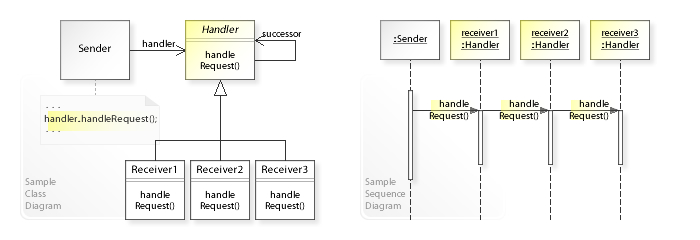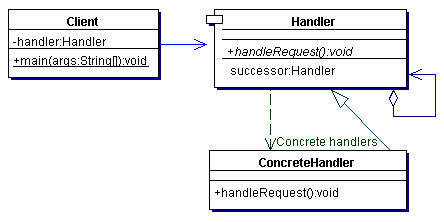Chain of responsibility pattern is used to achieve loose coupling in software design where a request from the client is passed to a chain of objects to process them. Later, the object in the chain will decide themselves who will be processing the request and whether the request is required to be sent to the next object in the chain or not.
前言 责任链模式(Chain of Responsibility Pattern)为请求创建了一个接收者对象的链。这种模式给予请求的类型,对请求的发送者和接收者进行解耦。这种类型的设计模式属于行为型模式。
责任链模式 基本介绍:
1) 职责链模式(Chain of Responsibility Pattern),又叫 责任链模式,为请求创建了一个 接收者对象的 链( 简单示意图) 。这种模式对请求的发送者和接收者进行解耦;
角色介绍:
1) Handler : 抽象的处理者, 定义了一个处理请求的接口, 同时含义另外Handler;
责任链模式-UML图:
责任链模式-实例图:
代码:
1 2 3 4 5 6 7 8 9 10 11 12 13 14 15 16 17 18 19 20 21 22 23 24 25 26 27 28 29 30 31 32 33 34 35 36 37 38 39 40 41 42 43 44 45 46 47 48 49 50 51 52 53 54 55 56 57 58 59 60 61 62 63 64 65 66 67 68 69 70 71 72 73 74 75 76 77 78 79 80 81 82 83 84 85 86 87 88 89 90 91 92 93 94 95 96 97 98 99 100 101 102 103 104 105 106 107 108 109 110 111 112 113 114 115 116 117 118 119 120 121 122 123 124 125 126 127 128 129 130 131 132 133 134 135 136 137 138 139 140 public class Chainofresponsibility public static void main (String[] args) ProgramApe ape = new ProgramApe((int ) (Math.random() * 30000 )); GroupLeader leader = new GroupLeader(); Director director = new Director(); Manager manager = new Manager(); Boss boss = new Boss(); if (ape.getExpenses() <= 1000 ) { leader.handleRequest(ape); } else if (ape.getExpenses() <= 5000 ) { director.handleRequest(ape); } else if (ape.getExpenses() <= 10000 ) { manager.handleRequest(ape); } else { boss.handleRequest(ape); } } } class SimpleResponsibility public static void main (String[] args) int request = (int ) (Math.random() * 3 ); switch (request) { case 0 : System.out.println("SMBother handle it: " + request); break ; case 1 : System.out.println("Aige handle it: " + request); break ; case 2 : System.out.println("7Bother handle it: " + request); break ; default : break ; } } } class ProgramApe private int expenses; private String apply = "爹要点钱出差" ; public ProgramApe (int expenses) this .expenses = expenses; } public int getExpenses () return expenses; } public String getApply () return apply; } } class GroupLeader public void handleRequest (ProgramApe ape) System.out.println(ape.getApply()); System.out.println("GroupLeader: Of course Yes!" ); } } class Director public void handleRequest (ProgramApe ape) System.out.println(ape.getApply()); System.out.println("Director: Of course Yes!" ); } } class Manager public void handleRequest (ProgramApe ape) System.out.println(ape.getApply()); System.out.println("Manager: Of course Yes!" ); } } class Boss public void handleRequest (ProgramApe ape) System.out.println(ape.getApply()); System.out.println("Boss: Of course Yes!" ); } }
总结 责任链模式的注意事项和细节:
1) 将请求和处理分开,实现解耦,提高系统的灵活性;
延伸 责任链模式-菜鸟教程 Java设计模式 - 责任链模式 行为型设计模式-责任链模式 Chain of Responsibility Design Pattern 尚硅谷Java设计模式,韩顺平图解java设计模式

